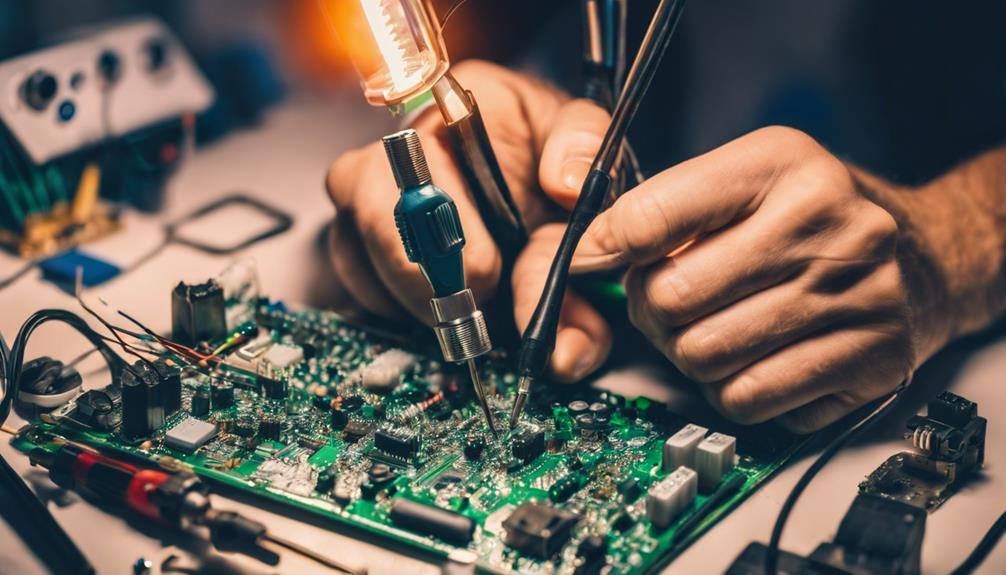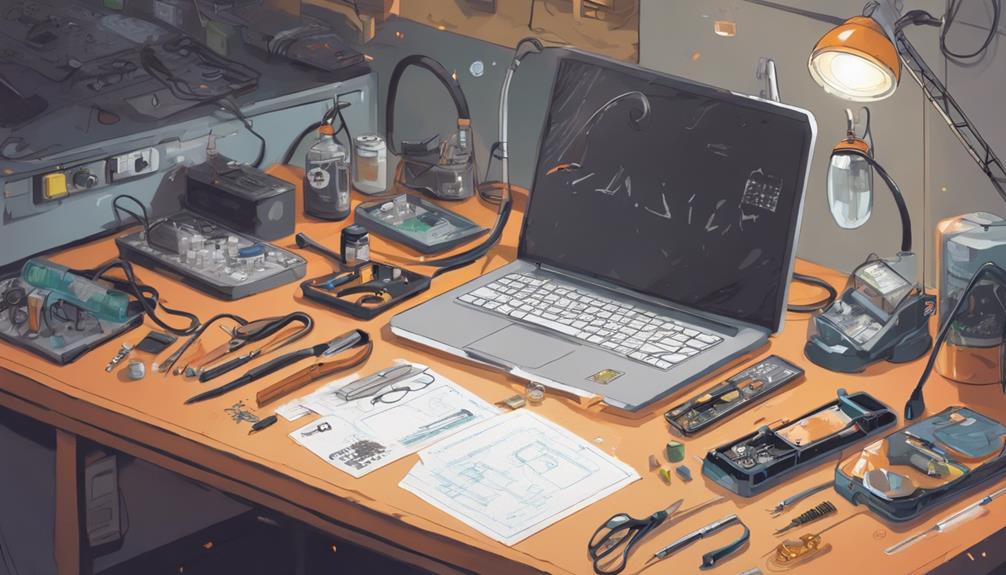To solder small components like a pro, mastering techniques and choosing the right tools are essential. Pre-tinning wires and pads, utilizing high heat, and maintaining a clean soldering tip are key to efficient heat transfer and robust joints. Preparation is critical, including cleaning components, pre-tinning, and ensuring proper temperature control. Safety measures, such as wearing goggles and working in a well-ventilated area, should not be overlooked. By following these essential tips, you'll be well on your way to achieving professional-grade soldering results. As you refine your skills, you'll discover the nuances of soldering small components and reveal the secrets to precision and reliability.
Key Takeaways
- Utilize a temperature-controlled soldering iron with a fine cone tip for precision and efficient heat transfer on small components.
- Pre-tin wires and pads before soldering to ensure robust joints and minimize time on the pad.
- Maintain a clean soldering tip and workspace to prevent oxidation and ensure reliable connections.
- Apply solder quickly and evenly to achieve strong bonds, and remove excess solder for clean connections.
- Inspect joints under magnification to ensure proper pad clearance and prevent short circuits.
Mastering Soldering Techniques
To achieve professional-grade soldering results, it is essential to master the fundamental techniques that guarantee strong, reliable connections, particularly when working with small components.
A critical aspect of this mastery is pre-tinning wires and pads before soldering, ensuring a strong joint and expediting the process.
When soldering, it is important to utilize high heat, around 800-850 degrees, for quick solder melting, thereby minimizing damage to pads.
To efficiently solder small components without overheating, it is crucial to work with the shortest time possible on the pad.
Effective heat transfer is also important, and this can be achieved by maintaining a clean soldering tip using a wet sponge or wire ball. This ensures cleaner joints and efficient heat transfer.
By employing these techniques, professionals can create robust solder joints that withstand the demands of small components.
Choosing the Right Tools

When soldering small components, selecting the right tools is essential for achieving professional results.
The first step in choosing the right tools is selecting a suitable soldering iron, which should have a fine cone tip for precision and a temperature control feature to guarantee consistent heat application.
Soldering Iron Selection
Frequently, the key to successful soldering of small components lies in selecting the best soldering iron, which is often a critical yet overlooked aspect of the process. A good soldering iron is essential for achieving a strong and reliable solder joint.
For precise soldering tasks, a cone tip is ideal, offering better control and precision compared to wedge tips. This makes them perfect for soldering tiny components on printed circuit boards.
When working with small components, pre-tinning wires and pads before soldering guarantees a strong joint and speeds up the process. Using a high-quality soldering iron with a cone tip, you can achieve efficient soldering of small components like FPV wires or delicate connections.
Iron Temperature Control
Every successful soldering operation involving small components hinges on precise iron temperature control, making it essential to select a soldering tool with advanced temperature management capabilities.
Proper temperature control guarantees that the soldering iron delivers the best amount of heat, preventing damage to sensitive components and printed circuit boards (PCBs).
A high-quality soldering station with adjustable temperature control is ideal for delicate work on small components, allowing for precise heat management and consistent results. This is particularly essential when working with lead-free soldering, which requires a higher melting point than traditional solders.
By maintaining the correct temperature, you can achieve clean, reliable solder joints on even the tiniest electronic parts. Inadequate temperature control can lead to cold or brittle joints, compromising the integrity of the entire assembly.
Preparing Components for Soldering

Proper preparation of components is essential for achieving reliable solder joints, and it begins with a thorough cleaning of the components to remove dirt and residue that can compromise adhesion. This step is critical in ensuring a strong bond between the component and the solder.
| Step | Description |
|---|---|
| Cleaning | Remove dirt and residue from components for better adhesion |
| Pre-tinning | Apply a thin layer of solder to pads and wires for easier soldering |
| High Heat | Use high heat to minimize time on the pad and prevent damage |
When preparing components for soldering, it's crucial to pre-tin pads and wires to make the soldering process easier and ensure a strong joint. Additionally, using high heat minimizes the time on the pad, preventing damage to solder pads. This approach also enables quick work, which is crucial for efficient soldering. By following these steps, you can ensure reliable solder joints using lead-free solder and solder paste. Remember, proper preparation is key to achieving professional-grade soldering results.
Essential Soldering Safety Tips

When engaging in soldering activities, exercising caution and adhering to essential safety guidelines is important to preventing injuries and ensuring a safe working environment.
To safeguard your eyes from solder splashes and fumes, always wear safety goggles. It is equally essential to work in a well-ventilated area or utilize a fume extractor to minimize exposure to potentially hazardous solder fumes.
When handling the soldering iron, avoid direct contact with the tip to prevent burns, and always place it on a heat-resistant surface when not in use. Additionally, it is necessary to keep a fire extinguisher nearby in case of accidental fires.
A clutter-free workspace is also crucial to prevent accidents and ensure a safe soldering environment. By following these essential safety tips, you can minimize the risks associated with soldering and focus on achieving professional-grade results.
Effective Heat Transfer Methods
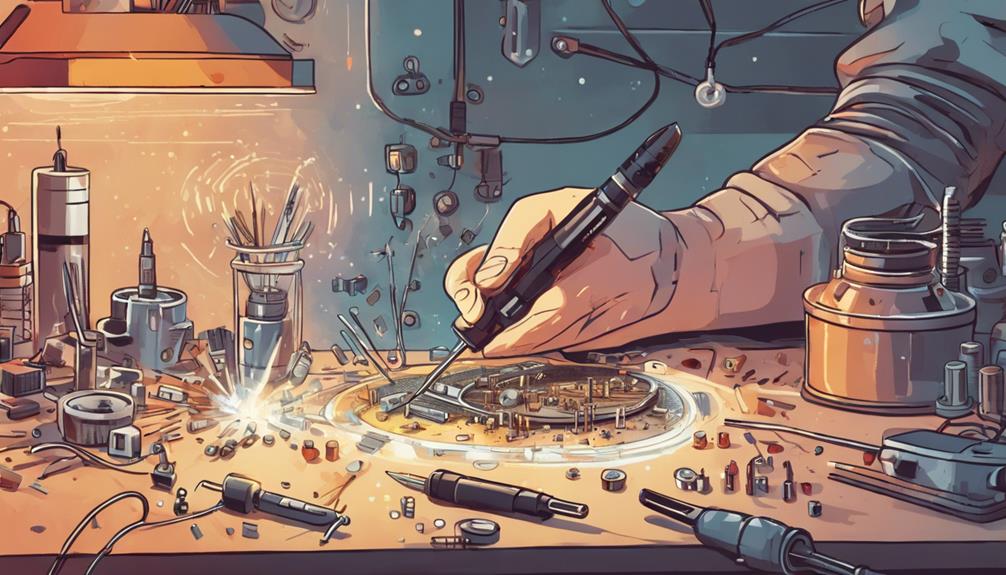
In high-density electronic assemblies, efficient heat transfer is essential for creating reliable connections, and a well-maintained soldering iron set to the optimal temperature is necessary for achieving this goal.
A temperature-controlled soldering iron ensures that the heat is transferred efficiently to the small components, facilitating a strong bond between the tin and lead solder and the solder pad.
To maximize heat transfer, it is important to make sure the soldering tip is clean, preventing oxidation on the components and promoting a secure joint.
Pre-tinning both the component and the solder pad further facilitates fast and effective heat transfer during soldering.
When applying solder, do so quickly and evenly to create strong bonds with the small components.
Finally, avoid prolonged contact with the solder pad to prevent damage to the components while ensuring a secure joint.
Avoiding Common Soldering Mistakes
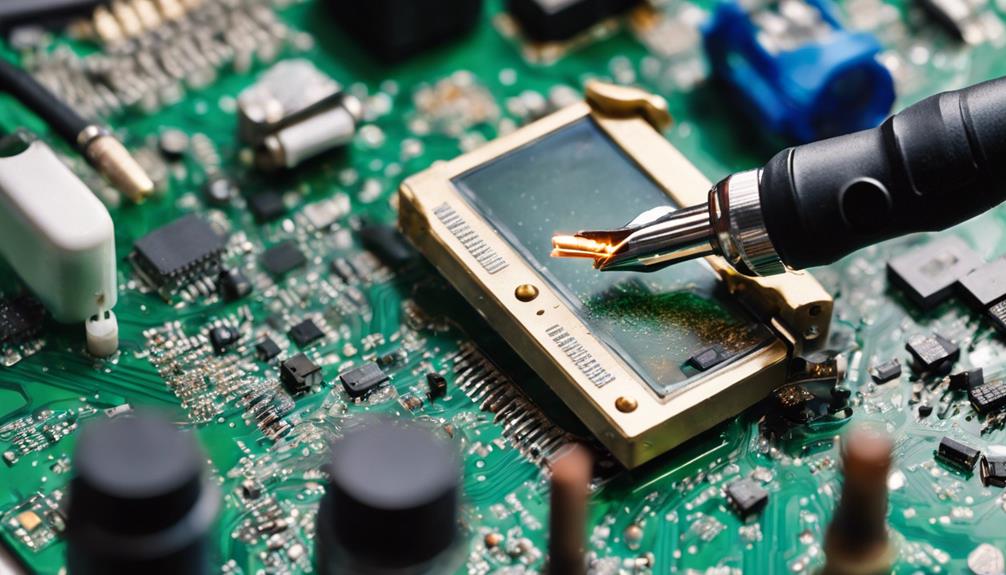
What pitfalls must be avoided to guarantee reliable connections and prevent damage to sensitive components during the soldering process? To make sure successful soldering, it is essential to avoid common mistakes that can lead to faulty connections and component damage.
One common mistake is the formation of solder bridges, which can occur due to excessive solder application or insufficient heat. To prevent this, use a flux pen to promote better solder flow and adhesion. Additionally, avoid overheating components by using a lower temperature setting on your soldering iron, preventing damage and component failure.
Another important consideration is component orientation. Double-check the orientation of components before soldering to prevent incorrect placements, which can lead to malfunctioning circuits. Additionally, secure components in place with a small amount of tacky flux before soldering to prevent movement during the process.
Soldering Small Wires and Pads
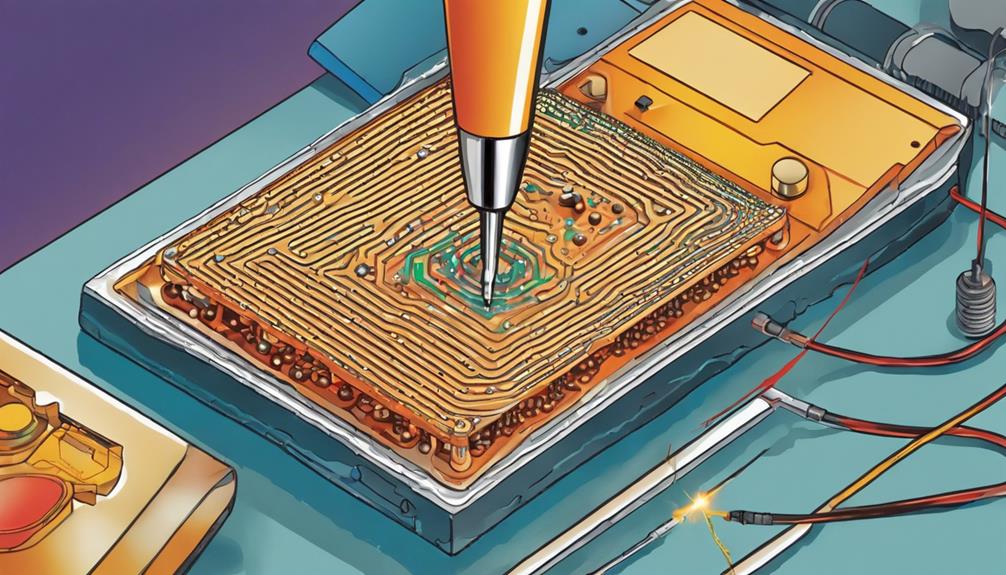
When soldering small wires and pads, attention to detail is vital to achieve reliable connections. To guarantee success, it is essential to focus on three critical aspects: wire preparation, pad clearance, and solder flow control.
Wire Preparation Matters
Properly preparing the wire and pad is vital to achieving a reliable and strong bond, as it sets the stage for a successful soldering process. To guarantee a secure joint, pre-tin both the wire and the pad before soldering. This essential step enables the solder to flow smoothly and evenly, resulting in a strong and reliable connection.
When working with small wires, such as FPV camera wires, high heat is necessary to minimize time on the pad and prevent damage. Heat the pad and wire separately, then bring them together with molten solder to ensure a secure joint. Quick work and efficient soldering techniques are essential for small wire soldering to prevent damage and ensure reliability.
Hold the wire steady until the solder cools to avoid any movement that may weaken the connection. By following these guidelines, you can achieve a strong and reliable bond, even with the smallest of components.
Pad Clearance Essentials
After achieving a strong bond between the wire and pad, attention turns to guaranteeing proper pad clearance between small wires and pads to prevent short circuits and establish dependable connections.
Insufficient pad clearance can lead to solder bridges, compromising the integrity of the connection. To avoid this, maintain a minimum clearance of 0.5mm between small wires and adjacent pads. Utilize magnification tools like a loupe or microscope to inspect and confirm pad clearance.
Verify that there are no unintentional connections caused by insufficient pad clearance, which can result in component damage. Clear pad spacing is vital for soldering accuracy, reducing the risk of component damage and ensuring dependable connections.
Solder Flow Control
Effective solder flow control is crucial when working with small wires and pads, as it directly impacts the strength and reliability of the bond between the two. To achieve the best results, mastering the art of solder flow control is vital.
Here are some key tips to get you started:
- Pre-tin both wires and pads before soldering to guarantee a strong bond
- Use high heat settings (around 800-850 degrees) for quick melting of solder on small wires and pads
- Minimize the time the soldering iron is in contact with the pad to prevent damage
- Remove excess solder to maintain clean and reliable connections
Achieving Strong and Clean Joints
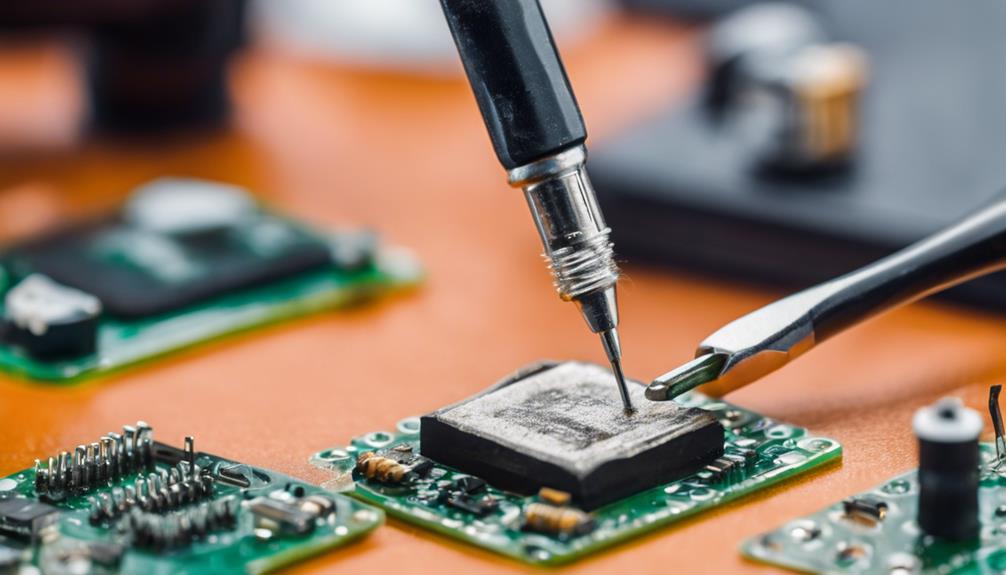
One key factor in achieving strong and clean joints is the ability to create a reliable bond between the wire and the pad, which can be facilitated by pre-tinning wires and pads before soldering. This process guarantees faster bonding and stronger joints.
When soldering, using high heat is crucial to minimize the time on the pad, preventing damage to the solder pads. Shortening the time of the soldering process with high heat also guarantees efficient and clean joints.
To further enhance joint reliability, add solder to weak joints and remove excess solder for strong joints. Properly soldering small components like FPV camera wires involves precise placement and quick cooling for secure joints.
By following these techniques, you can achieve strong and clean joints that withstand the demands of your application.
Troubleshooting Soldering Issues

Identifying and addressing soldering issues promptly is vital, as faulty joints can compromise the reliability and performance of the entire device. When troubleshooting soldering issues, it is important to identify the root cause of the problem to guarantee effective resolution.
Common soldering issues include:
- Insufficient solder: leading to weak joints and poor connectivity
- Excess solder: causing bridging between connections, short circuits, and damage to the circuit board
- Uneven heating: resulting in cold solder joints, which are weak and prone to failure over time
- Inadequate cleaning: hindering the solder's ability to bond effectively and creating unreliable connections
To overcome these issues, it is crucial to remove excess solder, ensure even heating, and maintain a clean soldering area.
Additionally, inspecting the solder joints under magnification can help identify potential issues before they become major problems.
Frequently Asked Questions
How to Solder on Small Components?
Did you know that 75% of electronics failures are attributed to poor soldering techniques?
To avoid such pitfalls, mastering the art of soldering small components is essential. When tackling this delicate task, precision is key. Begin by carefully handling components with precision tweezers, ensuring correct orientation and placement on PCB pads.
Apply a judicious amount of solder paste, and utilize a hotplate with precise temperature control to achieve efficient and reliable soldering results.
What Is the Best Tip for Soldering Small Electronics?
When it comes to soldering small electronics, the choice of tip is crucial. A cone tip is the best selection due to its precision and versatility. This tip type excels in fine wiring, small wire applications, and tiny component soldering, offering superior control and accuracy.
Its precision enables quick and reliable connections on small pads and components, making it the go-to choice for professionals and enthusiasts alike.
How Do You Solder Real Small Connections?
In the ancient art of soldering, precision is paramount. When tackling real small connections, employ the 'flux-facilitated' approach.
Apply a minute amount of solder paste to the PCB pad, then add a droplet of flux to facilitate capillary action. This synergy enables precise solder flow, ensuring strong, reliable bonds.
Mastering this technique demands finesse, but yields professional-grade results. By marrying precision with patience, even the most diminutive connections can be soldered with ease.
How Do You Solder Like a Pro?
To solder like a pro, master the art of precision and control. Develop a steady hand and sharp eye for detail to execute flawless joints.
Employ high heat and swift movements to minimize thermal stress and prevent damage to sensitive components. Pre-tin connections and utilize specialized tools, such as cone tips, to achieve precision and versatility.
Practice and refine your technique to produce strong, reliable connections that withstand the demands of high-performance applications.

